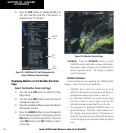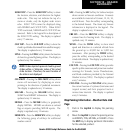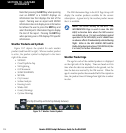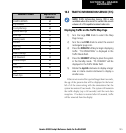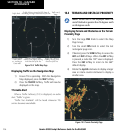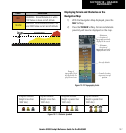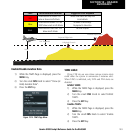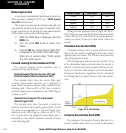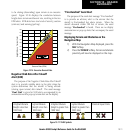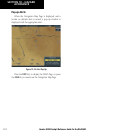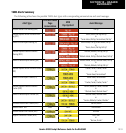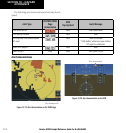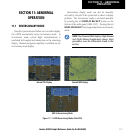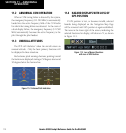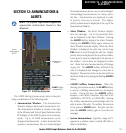
Garmin G1000 Cockpit Reference Guide for the DA40/40F
10-10
SECTION 10 – HAZARD
AVOIDANCE
Manual System Test
A system test is automatically performed at power-up.
After sucessful completion of the test, “TAWS System
Test, OK” will be heard.
The system test may also be initiated manually, but
only when the aircraft is on the ground. To manually verify
proper operation of the aural and visual annunciations
of the system, perform the following steps.
1) While the TAWS Page is displayed, press the
MENU
Key.
2) Turn the small
FMS
Knob to select ‘Test
TAWS’.
3) Press the
ENT
Key. During the test ‘TAWS TEST’
is displayed in the center of the TAWS Page.
When all is in working order, “TAWS System
Test, OK” will be heard.
Forward Looking Terrain Avoidance (FLTA)
The Forward Looking Terrain Avoidance alert is
composed of two sub-functions:
Reduced Required Terrain Clearance (RTC) and
Reduced Required Obstacle Clearance (
ROC)
This provides alerts when the aircraft flight path
is above terrain and/or obstacles, yet is projected to
come within minimum clearance values outlined in the
following table. When an RTC or ROC alert is issued, a
potential impact point is displayed on the TAWS Page as
a yellow or red ‘X’.
Imminent Terrain Impact (
ITI) and Imminent
Obstacle Impact (IOI)
This provides alerts when the aircraft is below the
elevation of terrain in the aircraft’s projected path. ITI and
IOI alerts are accompanied by a potential impact point
displayed on the TAWS Page as a yellow or red ‘X’. The
alert is given when the projected vertical flight path is
calculated to come within minimum clearance altitudes
in the following table.
Phase of Flight Level Flight Descending
Enroute 700 ft 500 ft
Terminal 350 ft 300 ft
Approach 150 ft 100 ft
Departure 100 ft 100 ft
During the final approach phase of flight, RTC/ROC/
ITI/IOI alerts are automatically inhibited when the aircraft
is below 200 feet AGL while within 0.5 nm of the approach
runway or is below 125 feet AGL while within 1 nm of the
runway.
Premature Descent Alert (PDA)
A Premature Descent Alert is issued when the system
detects that the aircraft is significantly below the normal
approach path to a runway. The PDA alert mode functions
only during descent to land.
PDA alerting begins when the aircraft is within 15 nm
of the destination airport and ends when the aircraft is
either 0.5 nm from the runway threshold OR is at an alti-
tude of 125 feet AGL while within 1 nm of the threshold.
During the final descent, algorithms will set a threshold
for alerting based on speed, distance, and other param-
eters.
Figure 10-15 PDA Alerting
Excessive Descent Rate Alert (EDR)
The purpose of the Excessive Descent Rate alert is to
provide suitable alerts when the aircraft is determined



